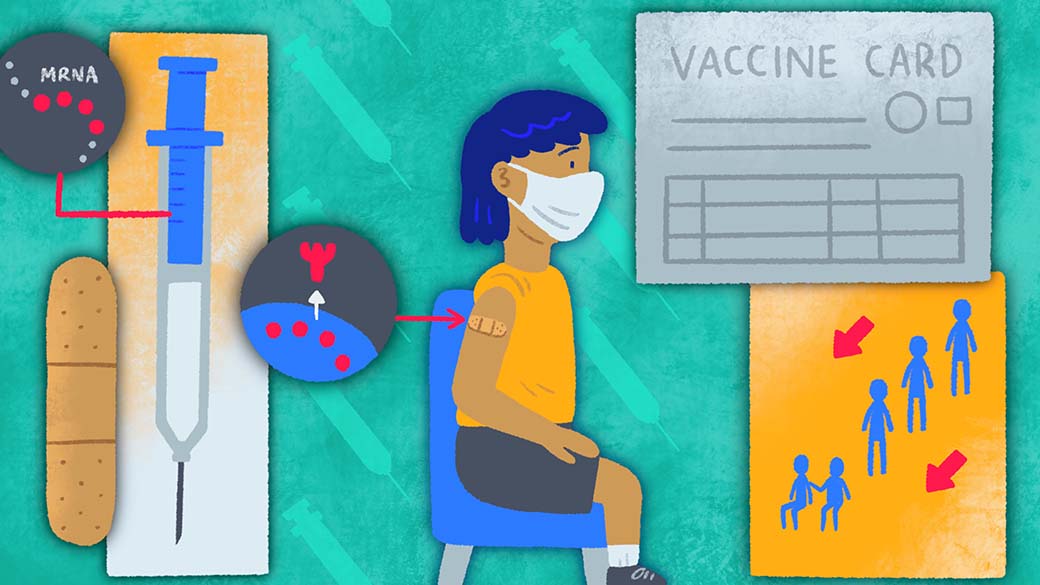The Quest Begins
The development and distribution of vaccines was key to ending the most serious aspects of the pandemic.
The development and distribution of vaccines was key to ending the most serious aspects of the pandemic.

Almost as soon as COVID-19 emerged as a global public health threat, scientists around the world threw themselves into developing a vaccine. Chinese scientists published the genetic sequencing of the virus in January 2020, and as the pandemic spiked, so too did the quest for a vaccine.
With so many lives on the line, the development of the COVID-19 vaccine was an unprecedented, worldwide effort with awe-inspiring speed, careful, scientific precision and selfless teamwork. Study data was published in open-access repositories months ahead of journal articles, viral genome sequences were shared and hundreds of clinical trials were launched.
“Somewhere what got lost in our country, I think, was what a miracle these vaccines were,” said Moira Szilagyi, MD, FAAP, who served as AAP president in 2022. “The mRNA technology had been in development for 40 years… The technology was there and this just happened to be available and ready to go when the pandemic hit. We were so fortunate.”
The approach to the COVID-19 vaccines has been in development for 40 years, and through determination, luck and the hard work of many, was ready to go when the pandemic hit.

In April 2020, the U.S. government launched Operation Warp Speed, a public-private partnership to facilitate and accelerate the development of a COVID-19 vaccine. Clinical trial timelines were compressed, and private manufacturers were secured to produce millions of doses.
When data on the impact of COVID-19 on children wasn't available, the AAP Research team collaborated with the Children’s Hospital Association to collect and share it.
The U.S. Food and Drug Administration granted emergency use authorization for the first vaccines in December 2020, but use was limited to adults. It would be nearly a year before vaccines were approved for children age 6-18.
“Children were without a vaccine for so long. And I think that that was the biggest challenge for the AAP: How do we keep children safe when there is no vaccine available for them?” Dr. Szilagyi said.


By the end of 2020, drug makers had concluded through critical trials that they could produce safe, effective COVID-19 vaccines.
Companies worked with Operation Warp Speed to plan for mass manufacturing and distribution of vaccines, which were allocated across the country based on the number of people in each state. The initial doses were reserved for health care and other front-line workers, as well as long-term care residents. By spring 2021, vaccines were widely available for adults.
“I would also say it was very personal for me. I had two teenagers at home and I had spent a lot of time reading about the vaccines and diving deep into the data and talking to our experts. Of course, that was part of my job. But it was also very personal because I was making those decisions for my own kids as well.”
- Dr. Lee Beers, 2021 president of the American Academy of Pediatrics and a professor of pediatrics at Children's National Hospital in Washington, D.C.

The unconventional approach to COVID-19 research and vaccine development opened the door for politicalization and skepticism. Some states were skeptical of federal oversight and planned extra levels of scrutiny, while online conspiracy theories cast doubt on the safety of the vaccines.
“The misinformation was challenging,” Dr. Szilagyi said. “What was really challenging was the disinformation. People purposely lying for their own ends, whatever those were. They had loud voices, you know, magnified through social media. So there were just challenges on many fronts.”
In an October 2021 AAP survey, one in four primary care pediatricians estimated that 50% or more of parents in their practice community would be extremely unlikely to vaccinate their 12- to 18-year-old children. Pediatricians in the South reported the highest estimates of resistance, with over a third reporting 50% or more of parents would be extremely unlikely to vaccinate.
“There is so much bad information out there, people don't know what to believe,” one survey respondent said.
“They all say they don’t want to experiment on their children who will likely have little to no symptoms if they are infected with COVID,” said another respondent.
The AAP sought to set the record straight by distributing accurate information through social media, traditional media, HealthyChildren.org, biweekly town hall meetings, interim guidance, vaccine resources for pediatricians, and a free PediaLink course on communicating with families about vaccines.

In June 2021, the AAP Research team began tracking the progress of COVID-19 vaccination among U.S. children by analyzing and summarizing data posted by the Centers for Disease Control and Prevention (CDC). Reports were posted to the AAP website each week after the vaccine became available for children.
By May of 2023, 68% of children aged 12-17, 39% of children aged 5-11 and 13% of children aged 6 months to 4 years had received at least one dose of COVID-19 vaccine. Overall, about 81.4% of the U.S. population had gotten at least one vaccine dose.
Find the AAP's policy, guidance, vaccine information and more.
09/20/2023
American Academy of Pediatrics